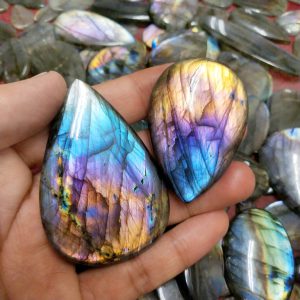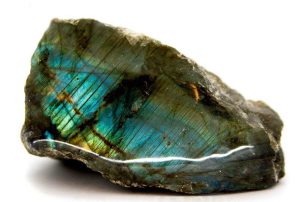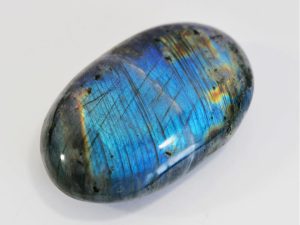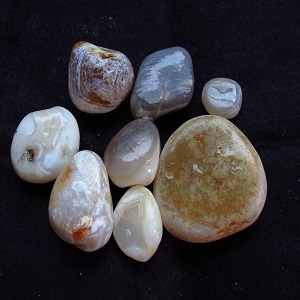?What is Labradorite

Labradorite stone is a member of the feldspar family and is usually found in gray, green, smoky, black and white, and whitish gray colors
The refraction of light in the layers of labradorite stone causes this stone to twinkle and shine and creates a rainbow of blue, gold, pale green and red lights. One of its distinctive features is that when you turn this stone, You can see a spark of reflection of blue light. This effect is created as a result of light splitting in the layers of the stone. When this stone is seen from other angles, it emits a captivating color that can be seen on the beaches of Labrador. searched
:The history and origin of labradorite and its sources
Labradorite stone was first discovered in Canada and was used as a popular gemstone in Europe in the 18th and 19th centuries. Labradorite is a stone whose name is derived from the Labrador region in Canada, where it was first found on Bridge Island. Paul- was found in 1770 AD. Labradorite is found in metamorphic rocks (especially gneiss), sedimentary and especially in mafic igneous rocks, gabbro, norite and anorthosite. Therefore, labradorite reserves are very abundant. Labradorite is found in Canada, Australia, Madagascar, Mexico, Norway, Russia and America. A significant amount of gray to black labradorites with labradorsense color play are produced in Russia and Madagascar. In Madagascar, there is a clear blue labradorite known as Madagascar Moonstone. Small amounts of the clear type with internal color reflections are mined in India. The best labradorite phenomenon is found in the labradorite rock, specific to a few deposits in the area of Finland known as “Spectrolite” named by the Geological Survey of Finland. Several mines in the US state of Oregon have labradorites with yellow, orange, red, blue, green and transparent types without color play. These samples are great for thrashfest. Some of these stones have copper particles in them, which in the right axis with the inner layers of labradorite also cause the reflection phenomenon of inversions. These stones under the Oregon Sunstone brand are very popular with collectors
:How to identify the original labradorite stone

Without seeing the reflective phenomenon of light and labradorsense color, it is difficult to recognize natural labradorites that do not have this play of color, and it requires tests such as x-rays, chemical analysis, optical tests, or its specific weight. Nowadays, synthetic samples made of polymer materials are also produced as substitutes for labradorite. Also, improved and dyed samples are sometimes sold as original and natural labradorite, which can be identified by excessive accumulation of one color in the labradorite. The streaks and its spreading pointed to the underlying color like green. In general, there is no acceptable improvement in labradorite and its painted samples are quite distinct, discolored and lifeless. Labradorite is considered a semi-precious and cheap stone, and maybe if its resources were few, it would be a very precious stone due to its beauty. The price of labradorite is considered warm. The most valuable type of this stone is labradorite that has a full range of colors and can be seen
?How many types of labradorite are there
Spectrolite: It is a very rare example of labradorite that is obtained from Finland
As its name suggests, it displays a range of colors
Andesine-Labradorite: It is a stone obtained by upgrading labradorite
Rainbow Moonstone, sometimes with the trade name Madagascar Moonstone: as its name suggests, it is a blue stone that is obtained from the Madagascar region
?What is the color range in labradorite
The color of this stone is from gray to gray-black and with a color spectrum that is created by the decomposition of light in the layers of the stone
The favored colors in this stone are blue court and color combination. This stone can be colorless or red-orange or brownish
The metallic effects of this stone – especially in the spectrolite type – can represent the full range of colors in it
?Why is there labradorite phenomenon in labradorite
Labradorite is the only member of the plagioclase family that has a strong labradorite color game phenomenon. During the formation of labradorite in the depths of the earth, with the lowering of the temperature, sodium aluminum silicate layers are separated from calcium aluminum silicate and a twin state is created

:The degree of transparency and brilliance of labradorite
When labradorite is exposed to light, and seen from different directions, its color spectrum can be seen. Transparent and semi-transparent labradorite are generally blue in color. And the higher the transparency, the less the role of color will be. This stone has transparent, semi-transparent and opaque samples. But its semi-transparent samples are more popular
:How to cut and cut and various ideas that can be used to design labradorite stone
This stone is usually cut into necklace pendants and decorative designs. Transparent labradorites can be cut in polyhedral and spherical forms (for use as beads in jewelry). This stone can be easily cut into decorative designs, pierced or turned into polyfaces and on silver and gold. It is usually used in making necklaces and rings

Also, when it is used to make earrings and beads, it will be cut in a spherical shape. Depending on the type of cut and cut, labradorite can be used for men and women
Although this stone is softer than quartz, it is more durable
In fact, Labradorite has been popular for its beauty and luster since the Victorian era
Different types of this stone that have a hollow design usually have better strength against scratching. When buying precious stones, pay more attention to their size than their carat weight. The ratio of size to weight of colored stones is different
:Gemological and geological features of labradorite
Chemical formula: NaAlASi3O8 to CaAl2Si2O8 aluminum calcium sodium silicate
Crystal structure: broad and prismatic
Color: dark gray-blackish gray, no color, orange red, brownish

Difficulty: 6.5-6
Refraction: 1.559-1.570
Density: 2.65-2.75
Fracture: Complete
Transparency: transparent to opaque
Light refraction: 0.008 to 0.010
Shine: glassy
Fluorescence: with yellow streaks
?Which stones are similar or related to Labradorite
This stone is in the group of feldspars and therefore has the closest relationship with plagioclase. This relationship is due to the presence of calcium and sodium in their composition
Among these stones are Albite, Oligoclase, Andesine Labradorite, Bytownite and Anorthite
This group of stones have properties in their composition that these materials are found abundantly in the structure of the earth’s crust
Albite has more light refraction compared to labradorite, while oligoclase is lower than labradorite
Andesine also has a lower degree of light refraction compared to labradorite
Bitonite is usually colorless, white, gray or pale yellow, while labradorite has dark colors. Anorthite is more transparent than labradorite. Rainbow moonstone, which is generally obtained from Madagascar, is a transparent material that has a deep metallic blue color
:Now let’s talk about some famous labradorite types
Although many famous labradorites are unknown, a number of historically and culturally valuable examples exist
One of these examples is a stone soldier whose historical period remains uncertain and is kept in the Smithsonian Museum in Washington. Labradorite stone was used in the 19th century as a decorative material in St. Isaac’s Cathedral in St. Petersburg, Russia
:Labradorite care tips

Despite the fact that this stone has a hardness of 6 to 6.5 and is softer than quartz, it is a very resistant and durable material. To clean this material, use water, foam and a clean cloth
After washing the stone, rinse it completely and remove the soap completely
Before doing heavy activities, exercising or bathing, take off all your jewelry. Also, do not place labradorite next to other jewelry so that it does not get scratched
The best way to store it is in a soft cloth or in a gold and jewelry box covered with cloth




